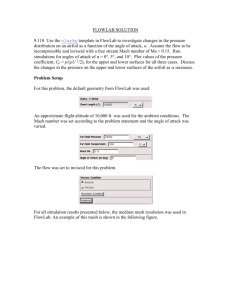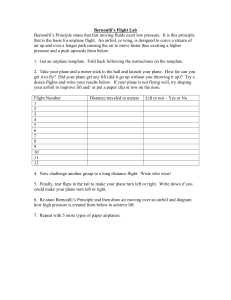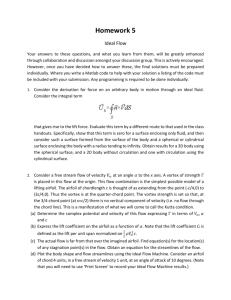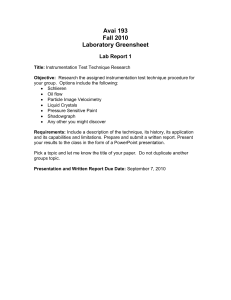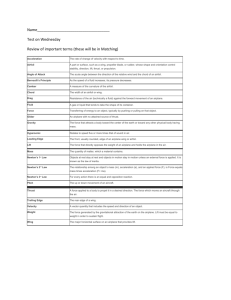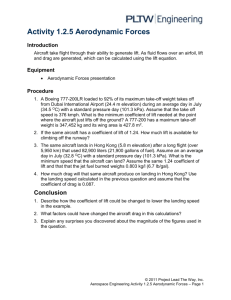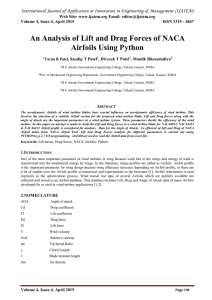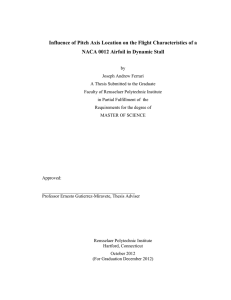Airfoil Pressure Distribution & Lift Measurement
advertisement
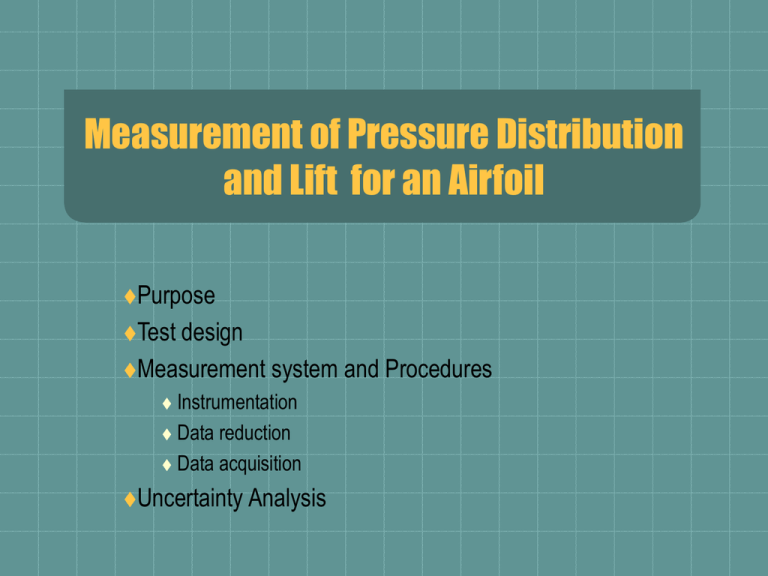
Measurement of Pressure Distribution and Lift for an Airfoil Purpose Test design Measurement system and Procedures Instrumentation Data reduction Data acquisition Uncertainty Analysis Purpose Examine the surface pressure distribution on a Clark-Y airfoil Compute the lift and drag forces acting on the airfoil Specify the flow Reynolds number Compare the results with benchmark data Uncertainty analysis for Pressure coefficient Lift coefficient Test Design Facility consists of: Closed circuit vertical wind tunnel. Airfoil Load cell Temperature sensor Automated data acquisition system Test Design (contd.) Airfoil (=airplane surface: as wing) is placed in test section of a wind tunnel with free-stream velocity of 15 m/s. This airfoil is exposed to: Forces acting normal to free stream = Lift Forces acting parallel to free stream = Drag Only two dimensional airfoils are considered: Top of Airfoil: The velocity of the flow is greater than the free-stream. The pressure is negative Underside of Airfoil: Velocity of the flow is less than the the free-stream. The pressure is positive This pressure distribution contribute to the lift Measurement systems Software - Surface Pressure - Velocity - WT Control Instrumentation Protractor – angle of attack Resistance temperature detectors (RTD) Pitot static probe – velocity Scanning valve – scans pressure ports Pressure transducer (Validyne) Digital Voltmeter (DVM) Load cell – lift and drag force Digital i/o PC A/D Boards Serial Comm. (COM1) Metrabyte M2521 Signal Conditioner Scanivalve Position Circuit (SPC) Scanivalve Controller (SC) RTD Pressure Input Digital Voltimeter (DVM) Scanivalve Pitot Tube (Free Stream) Pressure Transducer (Validyne) Scanivalve Signal Conditioner (SSC) Pressure Taps Airfoil Model Bundle of tubes AOA, and Pressure taps positions Data reduction In this experiment, the lift force, L on the Airfoil will be determined by integration of the measured pressure distribution over the Airfoil’s surface. The figure shows a typical pressure distribution on an Airfoil and its projection . Data reduction Cp Calculation of lift and drag forces The lift force L is determined by integration of the measured pressure distribution over the airfoil’s surface. It is expressed in a dimensionless form by the pressure coefficient Cp where, pi = surface pressure measured, = P pressure in the free-stream The lift force is also measured using the load cell and data acquisition system directly. U = free-stream velocity, r = air density ( temperature), pstagnation = stagnation pressure measured at the tip of the pitot tube, L = Lift force, b = airfoil span, c = airfoil chord 2 pstagnation p U r CL 2L rU 2 bc L p p sin ds s p 2D CD D, r , U , b, c rU 2 bc pi p 1 rU 2 2 CL p sin ds s 1 rU 2 c 2 Calibration of load cell mass (kg) Volts 0 -0.021 0.295 -0.1525 0.415 -0.203 0.765 -0.3565 1.31 -0.5935 1.635 -0.7385 Program output Lift Curve fitting method Mass Calibration program -0.6 -0.4 -0.2 Volts y = -3.9781x - 0.0792 R2 = 0.9992 2 Fzavg 1.5 1 0.5 Linear 0 (Fzavg) -0.5 0 Data acquisition Setting up the initial motor speed Visualization of wind tunnel conditions Data acquisition (contd.) Data needed: Observation point list Sampling Rate Settling Time Length of each Sample Angle of attack Airfoil pressure visualization Calculation of lift force Program to measure lift force in volts Uncertainty analysis Uncertainty analysis Pressure coefficient C p f ( pi p , r , U ) 2 2 U Cp BCp PCp2 B B i 1 p _ p i 2 i 2 i 2 ( pi p ) C p pi p PCp 2S Cp 2 ( pi p ) B Cl f ( pi p , i , r , U , c) 2 2 U CL BCL PCL2 j 2 Cp Lift coefficient 2 rU 2 M j B i2 Bi2 (2pi p ) B(2pi p ) 2 CL i 1 PCL 2SCL M Benchmark data Benchmark data for pressure coefficient for AOA = 6 Benchmark data for pressure coefficient for AOA = 0 Benchmark data for lift coefficient 2 2 AOA = 6 0 0 20 40 60 80 100 -1 -2 -3 1.8 1 1.6 0 0 20 40 60 80 100 -1 -2 Lift coefficient (Cl) 1 Coeffcient of pressure (Cp) Coeffcient of pressure (Cp) AOA = 0 -3 1.4 1.2 1 0.8 0.6 0.4 0.2 0 -4 -4 0 x/c x/c 5 10 15 20 25 30 35 Angle of attack (AOA) Benchmark data for pressure coefficient for AOA = 13 2 2 AOA = 16 AOA = 13 1 0 0 20 40 60 -1 -2 -3 80 100 Coeffcient of pressure (Cp) 1 0 0 20 40 60 80 100 -1 Benchmark data for drag coefficient -2 0.4 -3 0.35 -4 x/c -4 x/c a) Distribution of the pressure coefficients for = 0, 6, 13, 16 and Re = 300,000; , Benchmark data Drag coefficient (Cd) Coeffcient of pressure (Cp) Reference data for CL Benchmark data for pressure coefficient for AOA = 16 0.3 0.25 0.2 0.15 0.1 0.05 0 0 5 10 15 20 25 Angle of attack (AOA) Reference data for CD 30 35
